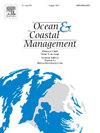Comparing ecosystem functioning with environmental cost: Life cycle assessments (LCA) of eco-engineered seawall enhancement units
IF 4.8
2区 环境科学与生态学
Q1 OCEANOGRAPHY
引用次数: 0
Abstract
The ongoing replacement of natural coastlines with ‘hard engineered’ coastal defenses has led to a decline in biodiversity and essential ecosystem services. As efforts to restore ecological health in urban coasts grow, strategies that retrofit habitat enhancement units, or ‘eco-units', onto existing seawalls have gained attention due to their ability to enhance biodiversity after installation. However, key functional measurements of the ecological communities that grow on eco-units remain limited, and concerns are emerging regarding the environmental costs of eco-unit production relative to their functional benefits. In this study, we compare the functional performance of eco-units deployed in Singapore with the environmental costs of their production and installation. Life cycle assessment (LCA) revealed that the carbon and nutrient removal capabilities of eco-unit communities were small compared to the climate change impact and marine eutrophication potential of their fabrication. Substituting Ordinary Portland Cement with Supplementary Cementitious Materials could substantially reduce the environmental impact of eco-units and offers a more effective means of reducing net emissions than relying solely on biological processes. Our findings highlight the importance of considering production-related environmental costs when evaluating the sustainability of eco-engineered strategies and indicate the critical role of material selection in the overall impact of eco-unit projects. Eco-units also provide other ecosystem services that are not part of LCA models and these need to be assessed using frameworks that consider a wider range of eco-unit benefits.
生态系统功能与环境成本的比较:生态工程海堤加固单元的生命周期评价
不断用“硬工程”海岸防御取代自然海岸线,导致生物多样性和基本生态系统服务的下降。随着恢复城市海岸生态健康的努力不断加强,在现有海堤上改造栖息地增强单元或“生态单元”的战略受到关注,因为它们在安装后能够增强生物多样性。然而,对在生态单元上生长的生态群落的关键功能测量仍然有限,并且对生态单元生产相对于其功能效益的环境成本的关注正在出现。在这项研究中,我们比较了在新加坡部署的生态单元的功能性能及其生产和安装的环境成本。生命周期评价(LCA)表明,生态单元群落的碳和养分去除能力与气候变化的影响和其制造的海洋富营养化潜力相比较小。用补充胶凝材料替代普通硅酸盐水泥可以大大减少生态单位对环境的影响,并提供比仅仅依靠生物过程更有效的减少净排放的手段。我们的研究结果强调了在评估生态工程战略的可持续性时考虑与生产相关的环境成本的重要性,并指出了材料选择在生态单元项目的整体影响中的关键作用。生态单元还提供不属于LCA模型的其他生态系统服务,需要使用考虑更广泛生态单元效益的框架对这些服务进行评估。
本文章由计算机程序翻译,如有差异,请以英文原文为准。
求助全文
约1分钟内获得全文
求助全文
来源期刊

Ocean & Coastal Management
环境科学-海洋学
CiteScore
8.50
自引率
15.20%
发文量
321
审稿时长
60 days
期刊介绍:
Ocean & Coastal Management is the leading international journal dedicated to the study of all aspects of ocean and coastal management from the global to local levels.
We publish rigorously peer-reviewed manuscripts from all disciplines, and inter-/trans-disciplinary and co-designed research, but all submissions must make clear the relevance to management and/or governance issues relevant to the sustainable development and conservation of oceans and coasts.
Comparative studies (from sub-national to trans-national cases, and other management / policy arenas) are encouraged, as are studies that critically assess current management practices and governance approaches. Submissions involving robust analysis, development of theory, and improvement of management practice are especially welcome.
 求助内容:
求助内容: 应助结果提醒方式:
应助结果提醒方式:


